|
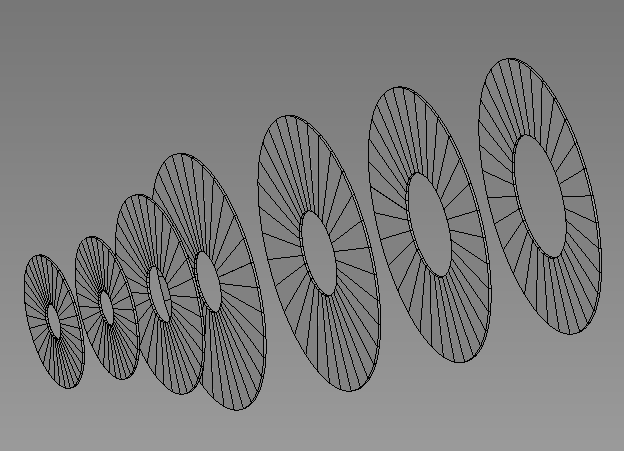 Vertexing with very forward tracks Vertexing with very forward tracks
In several ILC detector concepts (LDC, GLD) the vertex detector has a "long-barrel" layout. Cylindrical barrel layers provide a precise space point very close to the interaction point. In the LDC their angular coverage extends out to approximately 12.5 degrees. For very forward tracks the first measured point is on the Forward Tracking Disks. Even though the distance to interaction point may be quite large, the impact parameter of the track can be measured with a certain precision. In this section, the dependence on detector parameters of the vertexing capabilities for very forward tracks is discussed.
Setup
The impact parameter resolution is studied with a toy geometry that consists of 5 Vertex Detector layers. For each vertex detector layer a material budget of 0.12 % is assumed and a space point resolution of 5 &mu m × 5 &mu m. Two Silicon Intermediate Tracker layers at radii of 16 and 30 cm provide additional lever arm for central tracks. The space point resolution is assumed to be 10 &mu m in the R &phi coordenate, 1 mm in z. The impact of improving the z-measurement is negligible. The Forward Tracker in this toy model consists of seven disks in the nominal LDC positions, i.e. z= 20, 32, 44, 55, 80, 105 and 130 cm. The space point resolution of the three innermost disks is assumed to be 10 &mu m × 10 &mu m and the material per disk amounts to 0.12 % of a radiation length. The remaining four disks have a space point resolution of 10 &mu m in R &phi, but measure the second R-coordenate with 1 mm resolution. The material per disk is 0.8 % X0. As with SIT, these disks are only there to provide some lever arm for the transverse momentum measumements. The exact parameters are irrelevant for the vertexing performance.

A number of setups is defined, each corresponding to an interval in polar angle. For each of these the exact set of vertex detector and tracker layers is determined.
- I from &theta = 90 to 35 degrees tracks from the interaction traverse 5 vertex detector layers and SIT
- II from &theta = 35 to 25.8 degrees (within the largest cone in the drawing) tracks traverse 5 VXD layers plus the first Forward Tracker Disk.
- III from &theta = 25.8 to 18.5 degrees (within the second-largest cone in the drawing) tracks traverse at least 3 VXD layers plus the first two FTDisks
- IV from &theta = 18.5 to 12.5 degrees tracks traverse the second VXD layer plus the FTD disks
- V from &theta = 12.5 to 10 degrees tracks traverse the FTD without leaving any measurements in the vertex detector
- VI from &theta ~ 10 to 6.5 degrees (within the smallest cone in the drawing) tracks traverse the second and consecutive Forward Tracking Disks, missing the vertex detector and first FTD.
Results
For each setup, the vertexing performance is studied in terms of the resolution in the transverse and longitudinal impact parameter. In the figures below, the d0 (leftmost figure) and z0 (rightmost figure) resolution are shown as a function of particle momentum for a track at a 10 degree polar angle. The impact parameter resolution can be parametrized as the quadratic sum of two terms. The constant term is governed by the space point resolution of the innermost measurement. For sufficiently large momentum the resolution tends to the constant term. The second term - proportional to 1/p - represents the contribution due to multiple scattering. In the following results are given for two typical cases: tracks of 1 GeV and of 50 GeV.
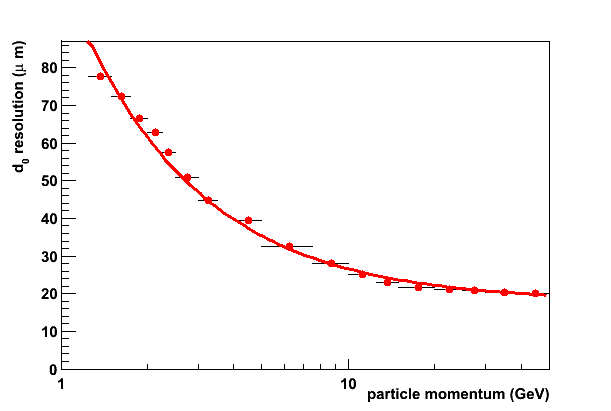 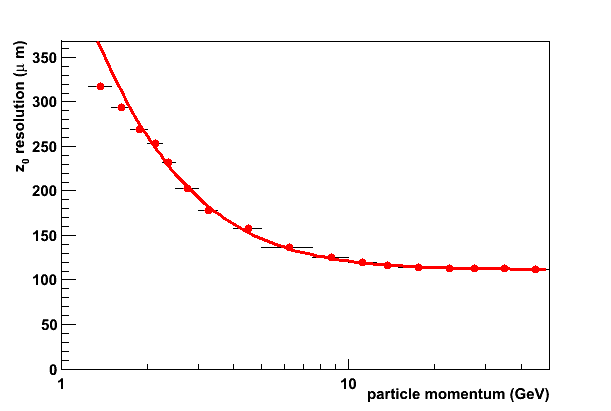
The results from all polar angle regions are summarized in the figures below. The lower edge of each arrow represents the asymptotic resolution for particles with large momentum. The upper edge corresponds to the impact parameter resolution of a 1 GeV track. The &theta regions listed above are colour-coded in the figure.
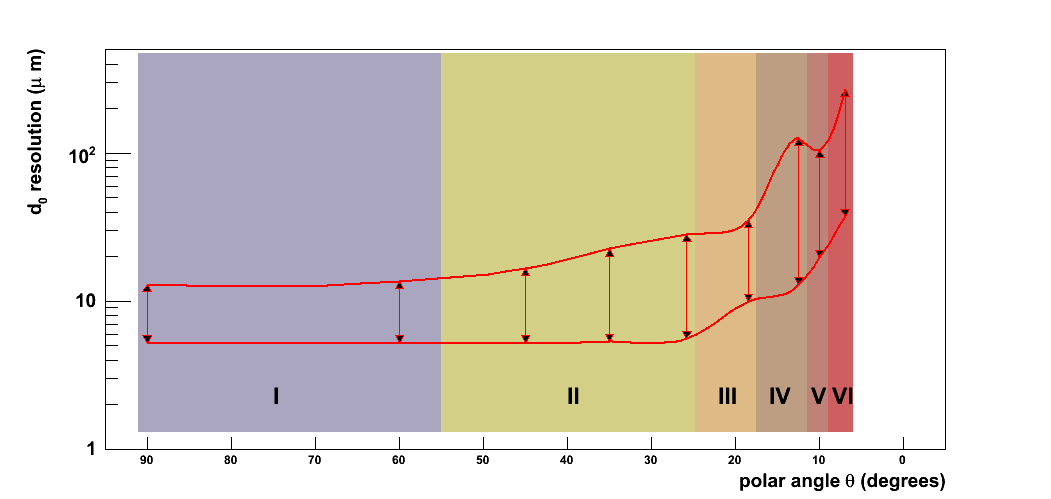
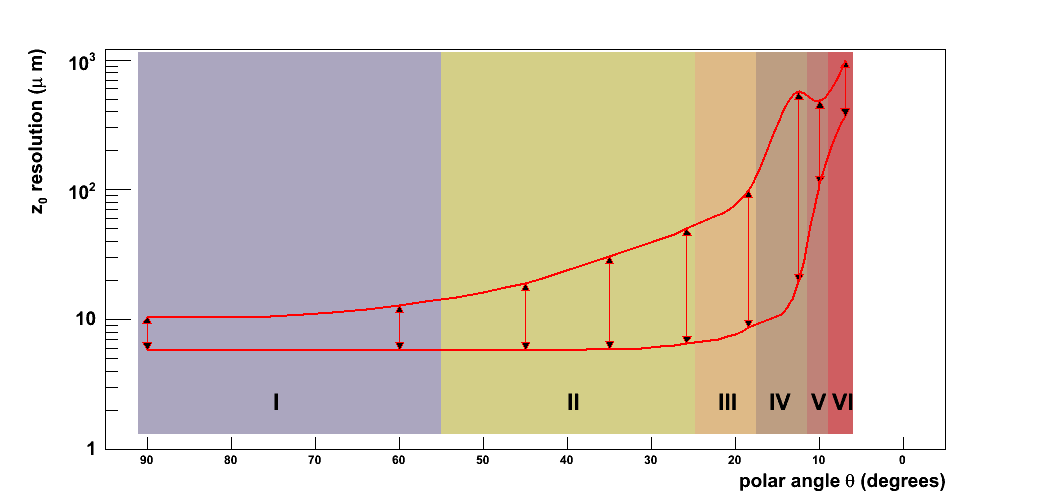
These results show how the long barrel geometry provides excellent impact parameter resolution for a large range of polar angles. The constant resolution term remains virtually unaltered down to polar angles of 25 degrees. The multiple scattering term grows slowly as a result of the increased path length in the silicon as the incidence angle in the barrel layers becomes shallower.
In region III the vertex detector still provides three precise space points. The constant term is approximately double that of the central region. For low momentum tracks the degradation is much more significant: a factor three in the transverse plane, nearly an order of magnitude for the longitudinal impact parameter.
In region IV only one precise space point in the vertex detector remains. Moreover, this point is on the second layer. Together with the small polar angle, this leads to a considerable increase in the distance from the innermost measurement to the interaction point. Where the transverse and longitudinal impact parameter for 50 GeV are still quite acceptable at 13 and 20 &mu m, respectively, for 1 GeV tracks the resolution has degraded to 130 and 570 &mu m.
For polar angles between 10 and 12.5 degrees - region V - the innermost measurement is provided by the Forward Tracker Disks. The constant term for the transverse impact parameter remains below 20 &mu m.The performance for 1 GeV tracks actually improves slightly with respect to the previous region due to the more favourable incidence angle in the disks. Due to the very shallow angle, the longitudinal impact parameter resolution degrades to beyond 100 &mu m for 50 GeV tracks, 500 &mu m for 1 GeV tracks.
For the even smaller polar angles of region VI the coverage of the first Forward Tracker Disk is insufficient and the innermost measurement is found on disk two, at a distance of 32 cm from the origin. Still, the transverse impact parameter degrades only to slighly below 40 &mu m for 50 GeV tracks. For low momentum tracks the resolution becomes 270 &mu m, of the order of the c &tau of B-hadrons. The longitudinal impact parameter is measured with a 400 &mu m resolution for high p tracks, and mm resolution for 1 GeV tracks.
Summarizing: The vertexing performance of a challenging FTD detector layout with a material of 0.1 % X 0/layer and a space point resolution of 10 &mu m × &mu m for the first FTD disks has been evaluated. While the performance is naturally quite far from that of central tracks, vertexing with very forward tracks is definitely a possibility.
For intermediate polar angles between 26 and 15 degrees the combination of a precise innermost measurement in the vertex detector with the lever arm provided by Forward Tracker Disks yields an asymptotic impact parameter resolution that is a factor 2-4 larger than that of central tracks. The multiple scattering contribution grows much faster and may become a severe threat in case the challenging material budget requirements of the vertex detector cannot be met.
Even for tracks at very small polar angles - that do not leave any hits in the vertex detector and rely on the FTD for the innermost measurement - the transverse impact parameter resolution remains well below the c &tau of B-hadrons.
Dependence on the FTD design parameters
Naturally, the performance depends strongly on the inputs of the model. To get a feel of how critical each detector parameter is the measurements for the setup corresponding to region V have been repeated while varying the principal assumptions. In the table below the most important findings are reported.
| setup | &sigma (d0) | | &sigma (z0) | |
| | @ 50 GeV | @ 1 GeV | @ 50 GeV | @ 1 GeV |
| reference geometry | 20 | 120 | 112 | 485 |
| material FTD = 1.2 % X0 | 21 | 289 | 116 | 1500 |
| sigma (R) = 100 &mu m | 21 | 121 | 1000 | 1000 |
| FTD1 @ z = 15 cm | 17 | 82 | 90 | 354 |
| sigma (R &phi) = 5 &mu m | 13 | 104 | 112 | 481 |
| sigma (R &phi) = 5 &mu m, z = 15 | 9 | 74 | 90 | 352 |
Clearly, the main threat to vertexing at small polar angle is the material budget of the first Forward Tracker Disk. For a factor 10 increase in material the multiple scattering term more than doubles. Several ways are listed to improve the performance. A significant improvement of the transverse impact is achieved by either reducing the R &phi error of the first space point measurement or by moving the first disk towards the interaction point, while maintaining the same angular coverage.
Summary
For detector concepts where the vertex detector has a "long barrel" layout, the innermost measurement for very forward tracks is provided by the Forward Tracking Disks. The distance from the interaction point of 20 cm (in the LDC) is much larger than for the vertex detector. Nevertheless, provided the material of the first tracking disks can be kept at a challenging 1 &permil/disk, the transverse impact parameter of very forward tracks can be measured with a precision that is well below the average c &tau of B-hadrons.
Home
Next Article
|